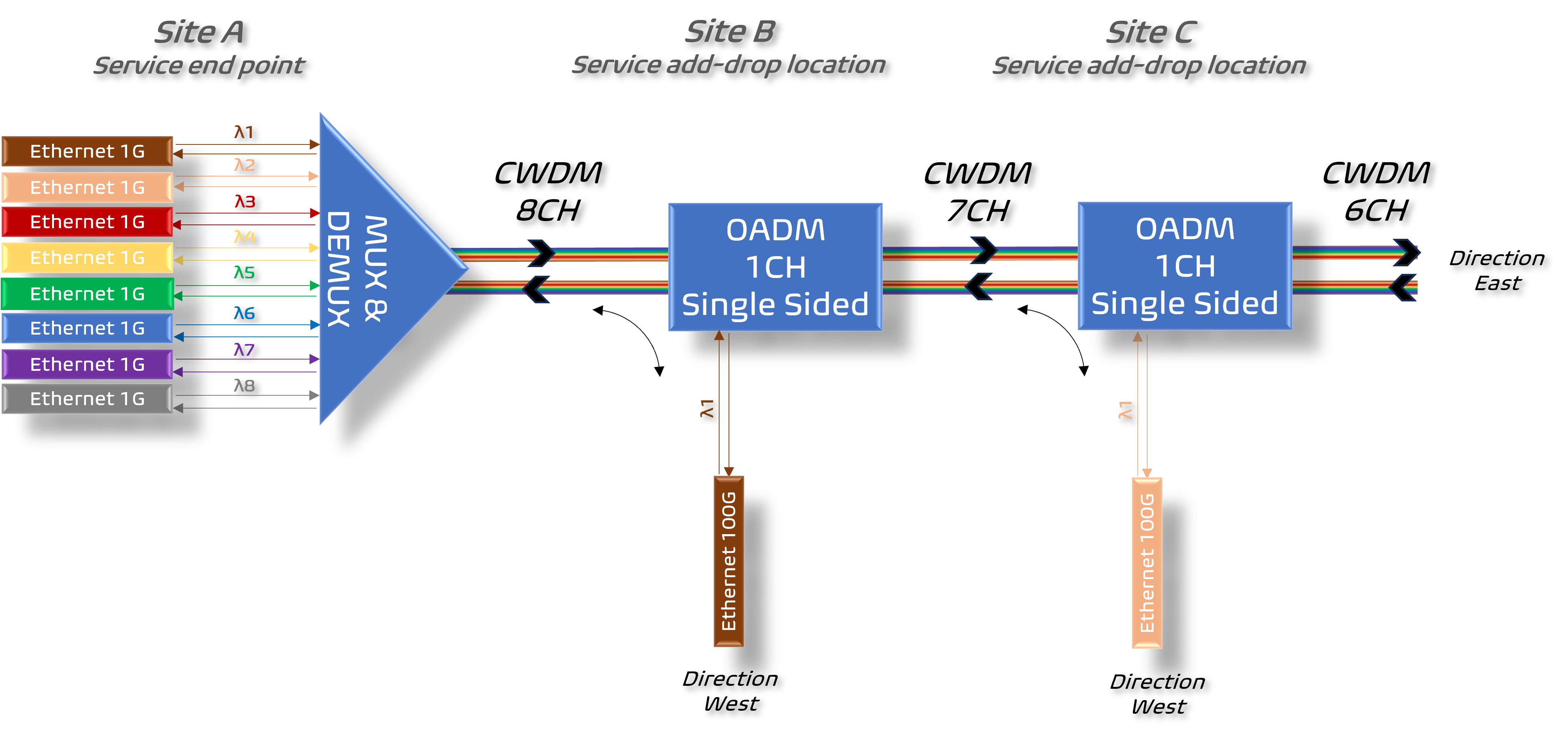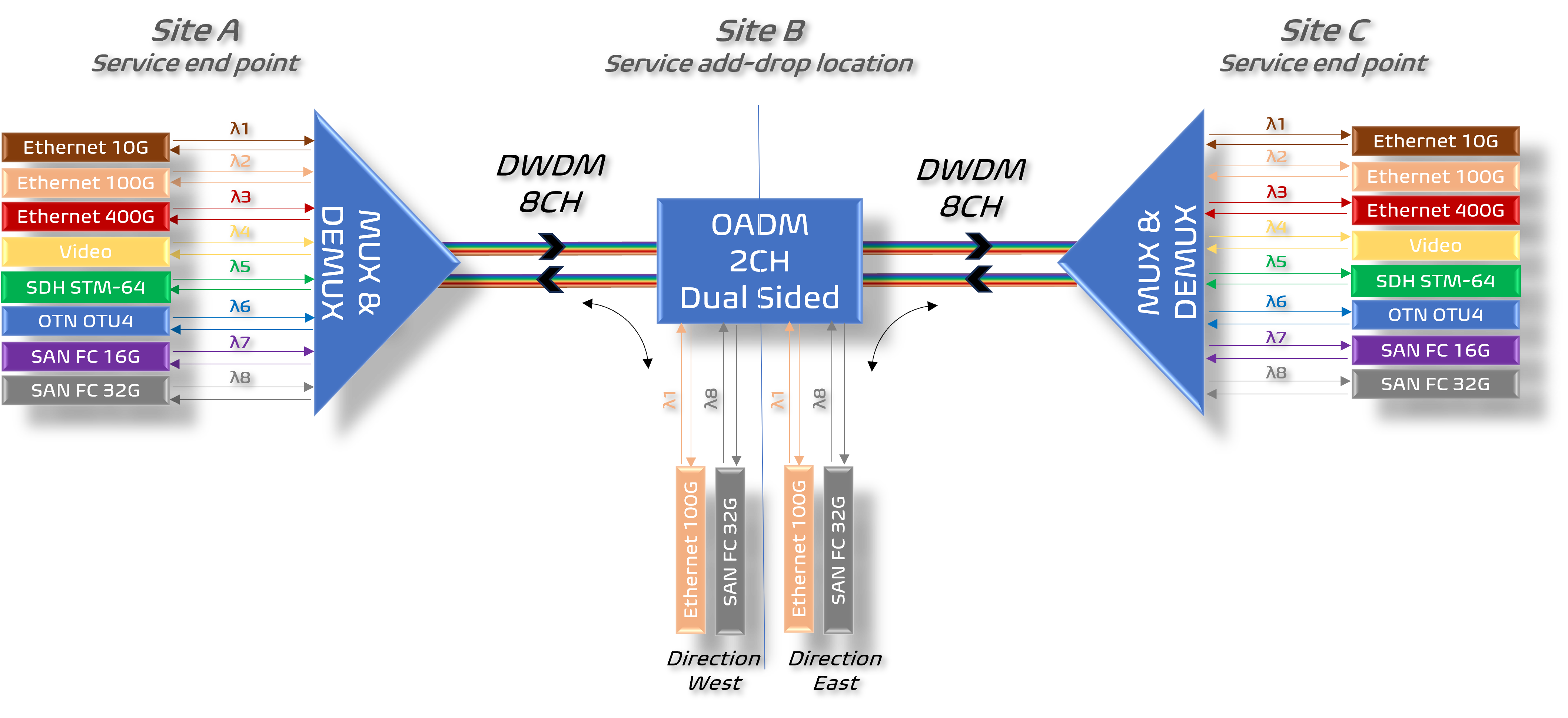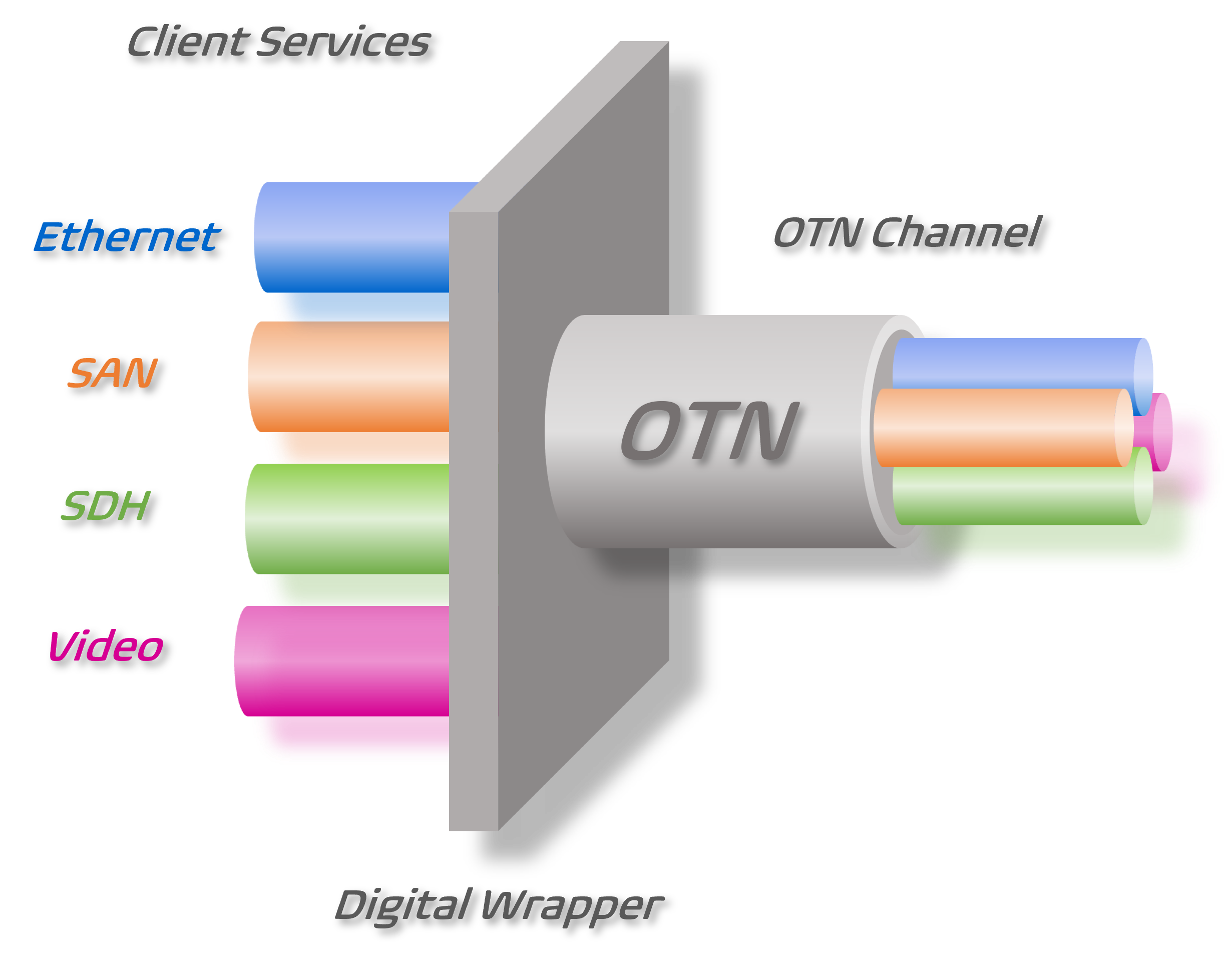Optical transport (CWDM, DWDM, OTN)
Wavelength Division Multiplexing (WDM)
Basics
With CWDM (Coarse Wavelength Division Multiplexing) and DWDM (Dense Wavelength Division Multiplexing) technologies, the data transmission capacity of optical links can be multiplied, and data streams of different speeds and protocols (Gigabit Ethernet, 10GE, 100GE, Fiber Channel, etc.) can be carried simultaneously but independently over the same optical fiber. The technology is based on the transmission of data streams using individual wavelengths (channels), which are multiplexed, demultiplexed and processed by passive or active WDM components. These channels are transparent to the speed and type of transmitted data. The simplest WDM connection that doesn't require additional WDM components is a single fiber link, where optical transceivers at both end use different wavelengths for transmitting data (e.g. 1310nm/1550nm or 1310nm/1490nm).
Who needs WDM?
In general, whoever needs to increase the transmission capacity of a fiber optic connection. This can be achieved by either adding more services (communication channels) of the same type or by mixing different services (e.g., Ethernet, Fiber Channel, CATV) that otherwise would require separate fiber links.
Application examples
WDM technology can be used to interconnect two buildings in the same campus, two sides of the road, within city borders or between cities.

If only a single strand of fiber is available instead of a fiber pair, we can still use CWDM or DWDM to multiply the transmission capacity of the connection. In that case however, we can transmit half the number of services of the available wavelengths (assuming full duplex connectivity). E.g., using 8 channel Mux and Demux we can establish 4 full duplex connection over single fiber.

In addition to simple Point-to-Point links, a typical application is interconnecting several sites along the fiber path to a central location. This is called linear add-drop topology. These sites could be surveillance camera locations connected to the surveillance center, tram stations connected to the traffic info center or ISP POPs in neighboring towns connected to an Internet Exchange.

Another version of add-drop topology is when WDM channels used to connect a service end point to an add-drop site are re-used at that add-drop site to provide connectivity to another direction as well.

More about WDM
The above layouts and applications are only samples of the practically infinite variations, which may include optical amplifiers, dispersion compensation units, reconfigurable optical add-drop multiplexers (ROADM) and other photonic layer components. If the CWDM or DWDM transceivers are plugged in directly to network equipment, we talk about passive WDM. If they are hosted by dedicated WDM nodes (plugged in to transponders or muxponders) we call it active WDM. The main benefit of passive WDM is its lower price as there are no active WDM nodes in the network. Then again, the advantage of active WDM is that the optical transport part of the network is separated from the connected networking devices. This on the one hand separates the management of the optical transport and the higher layer devices thus simplifies their trouble shooting and maintenance. On the other hand, in case the connected switches, routers, servers, etc. that are connected to the WDM nodes are replaced by equipment from differend brand or by devices with different form factor optical ports, the expensive WDM transceivers will not need to be replaced.
Optical Transport Network (OTN)
Basics
OTN is a standard method defined by ITU-T G.709 recommendation for transparent transport of services over optical fiber links or wavelengths in WDM systems. It is often referred to as digital wrapper technology or optical channel wrapper technology, whereas different traffic types - including Ethernet, Fiber Channel, SDH and others - are wrapped transparently into a high-speed stream for transport across optical networks.

OTN nodes are active devices that are able to provide functionality of transport, multiplexing, switching, management, supervision and survivability of optical channels. Products of different vendors that confirm to the standard can interface with each other, which allows building heterogenous and vendor independent optical networks.
Simply explained, while CWDM and DWDM technologies use Wavelength Division Multiplexing technique to multiply fiber capacity, OTN can be considered as a kind of Time Domain Multiplexing to maximize fiber efficiency.
Although OTN nodes can simply map client services into OTN signals of a similar line rate (i.e. 10G Ethernet into OTU2e or 100G Ethernet into OTU4), practically these devices are used to aggregate a mix of lower speed client services into higher speed OTN links.
Benefits
Maximizing the efficiency of an optical connection or DWDM wavelength by mapping a wide range of data streams transparently and flexibly into a higher speed link is probably the most practical, but not the only advantage of OTN technology. Here are some other key benefits of using OTN:
Improved performance with FEC (Forward Error Correction) - practically longer distances
Built-in service channel – GCC (General Communication Channel) can be used to transfer management information among nodes, so no need to allocate a dedicated wavelength for OSC (Optical Service Channel)
Improved management functionalities such us built-in real-time latency measurement and end-to-end service monitoring
Support for high data rates 100G and beyond - with the new, flexible nx100G format called OTUCn and FlexO
Standardizet multiplexing and switching - a given client interface connected to an OTN node can be connected to the corresponding client interface of any other node, and this connection can be reconfigured at any time
Application examples
Increasing the capacity of a fiber optic connection between two sites by aggregating multiple lower speed connections into a high speed link is one of the most common scenarios. In the example below, up to 20x10G data can be mapped into one 200G uplink. The larger the number of client services, the more cost effective the solution compared to using DWDM transceivers for each link.

As 400G optical transceivers have become more cost effective and widely available, the application of using OTN technology to aggregate 100G client services into 400G enjoys increased popularity.

The capacity and the service mix of OTN connections can be further extended by combining OTN and DWDM technologies. Each high speed OTN uplink is mapped to a unique DWDM wavelength, which are then multiplexed and demultiplexed by standard DWDM filters.

Bottom Line
WDM and OTN technologies are both have their own advantages and limitations related to transmission capacity, distances that can be covered, management and monitoring features, protection of services, scaling, automation capabilities, price tag and operational costs. They can be used independently or combined for increased capacity or functionality.
Our part
Teroline has extensive experience in the design and implementation of CWDM/DWDM and OTN solutions. Simple point-to-point interconnects, data centre mirroring, linear add-drop scenarios, protected service backbones and access networks are all part of our work. We select the most appropriate solution for your application from our portfolio of active and passive product families, keeping your technical requirements and financial possibilities in focus.
If you are familiar with optical transport technologies, you are welcome to browse through the related sections of our website yourself and pick the products you need.
